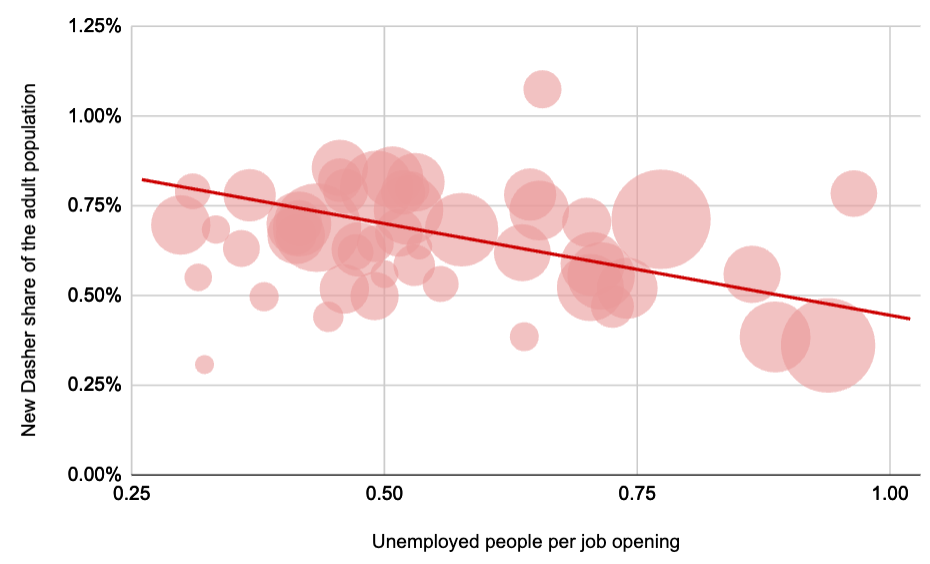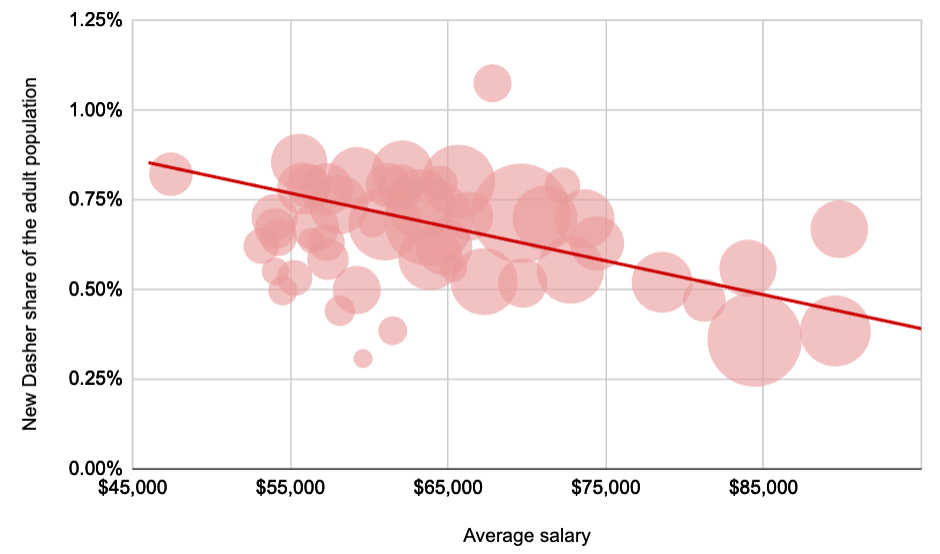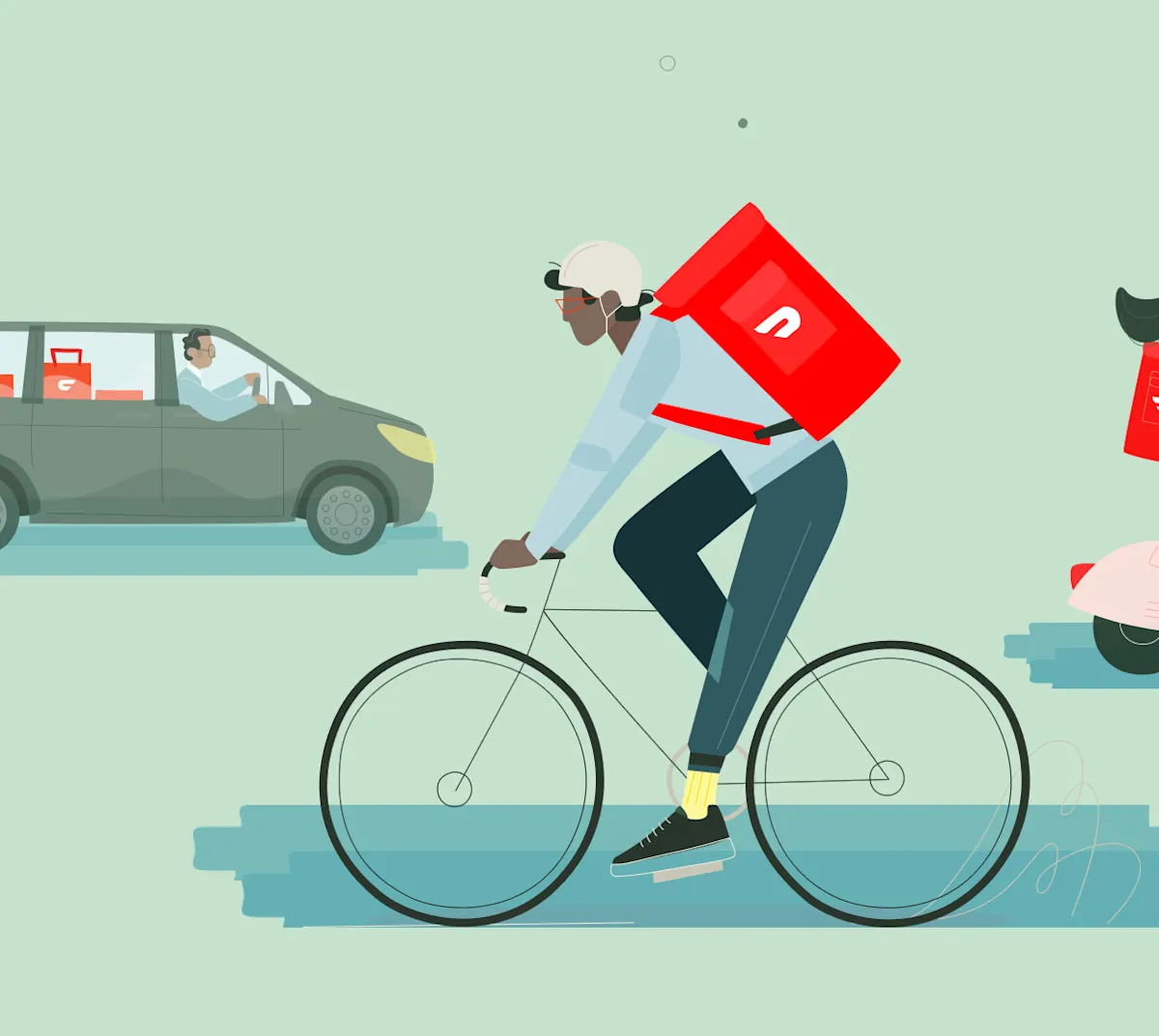Millions of Dashers have turned to DoorDash to earn supplemental income when and how it works for them. By pairing dashing with a full-time job, studying, or caring for loved ones, they’re able to save to meet financial goals, pay monthly bills, or treat themselves. However, one of the misconceptions about dashing is that people turn to dashing only when they can’t find a “traditional” job. If this were the case, we should be able to see this in the data: in particular, where unemployment rates are high — in states where it is difficult to find a “traditional” job — we would expect to see more people turn to dashing.
But this is not the case. To approximate demand for dashing, we look at the number of people who dashed for the first time in the first half of 2023 relative to the state population over 18. Comparing this to state-level unemployment rates in June 2023, we in fact see a negative relationship. That is, in states where unemployment rates are high, the number of new Dashers per capita is lower than in states where unemployment rates are low, on average. This suggests that people aren’t trying out dashing simply because they can’t find a “regular” job.
In states where unemployment is lower, new Dashers represent a larger share of the adult population

Other measures of labor market tightness — how many workers are available relative to job vacancies — tell the same story. For example, the Job Openings and Labor Turnover Survey (JOLTS) database tracks the number of unemployed people per job opening. It shows a similar pattern: there are more new Dashers in tighter labor markets, rather than what we might expect if people were only turning to dashing where they can't find a traditional job.
People turn to dashing even where traditional jobs are plentiful

This is also consistent with what Dashers themselves tell us. In 2023, only 4% of Dashers surveyed said that they chose to deliver with DoorDash because they were “not able to get other kinds of work.” In the second quarter of 2023, Dashers averaged less than 4 hours per week on delivery, with 90% spending less than 10 hours per week on delivery. This is because for most, dashing is a supplemental income stream — not a replacement for a 9–5 job. In fact, 61% of surveyed Dashers have full- or part-time jobs or are self-employed. Others may not have a full- or part-time job but still have other responsibilities, such as students (8%) or stay-at-home parents (10%). Three-quarters of Dashers say that less than half of their household income comes from dashing.
To further explore the extent to which dashing is supplemental, we can also compare the new Dasher share of the adult population with average salaries in each state. If dashing is largely supplemental, we might expect more people to turn to dashing when their salary from their traditional job doesn’t stretch quite far enough. The data support this hypothesis: where the average salary is lower, the share of new Dashers is higher. This suggests that where a full- or part-time job is insufficient, people are turning to dashing to supplement their incomes.
More new Dashers in states with lower average salaries

Academic researchers reach similar conclusions: in 2019, a paper using IRS tax data concluded that “Overall, our results offer no evidence that traditional full-time jobs are being replaced by non-employer “gig” work. However, we document that taxpayers are increasingly likely to have supplemental income from independent work—especially in the [online platform economy].” This holds in more recent years as well: in 2022, the New York Times reported that “[c]onventional employment opportunities abound, but online platforms still have appeal — for flexibility or additional income.” And a recent paper from the Federal Reserve Bank of Boston finds that “only 11 percent [of respondents] indicated engaging in gig work for “primary income,” and the average monthly earnings from gig work amounted to about 12.5 percent of their average monthly household income.”
Crucially, this supplemental income can be effective in reducing poverty. A study of people with multiple income sources found that the poverty rate among those with consistent casual secondary work was 5.7%, which would nearly double to 10.9% without that secondary income source. It also helps those transitioning between jobs — Dmitri Koustas, for example, found that earning on app-based platforms “replaced 73 percent of lost income from a main job, on average, and people don’t have to cut back their spending as much when they have a change in income.” And 67% of Dashers say they have dashed to make up for lost income or reduced hours at their full- or part-time job.
Erica, a Dasher from Alaska, tells us how dashing helps supplement the earning from her job: “As I already work a full-time 8-hour shift at an in-person job Monday through Friday, I need to be able to control when, where, and how often I dash. I have a busy personal schedule, working full-time, going to college to earn a degree and raising two children. I would not be able to commit to another regularly scheduled job! Dashing enables me to earn the extra income I need to make ends meet. With the rising costs of food, fuel, and every product across the board right now, I am able with my dashing income to cover all my household expenses without requiring any assistance!”
Notes: In the above charts, each bubble represents a state; the size of each bubble represents the number of Dashers active in that state in the second half of 2023. Best fit line is shown in dark red.
Sources: Bureau of Labor Statistics; Job Openings and Labor Turnover Survey; Census Bureau; Quarterly Census of Employment and Wages; internal DoorDash data.


